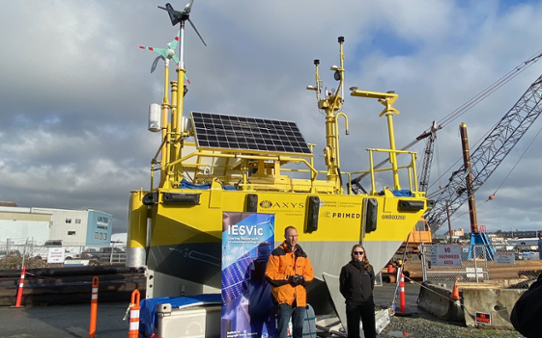Wind buoy could help remote coastal communities ditch diesel dependence

2021 November – Weighing in at 5,500 kg, a locally designed and manufactured buoy will be the first of its kind in BC waters to relay rich data about offshore wind. The buoy is part of a unique UVic project to help remote BC coastal communities replace or reduce their diesel requirements by harnessing wind power from the sea. It will be deployed in November near Trial Island.
The buoy is a project of UVic’s Pacific Regional Institute for Marine Energy Discovery (PRIMED), a lab led by Buckham and fellow mechanical engineering researcher Curran Crawford. PRIMED is part of the Institute for Integrated Energy Systems (IESVic) at UVic.
Currently, off-grid communities tend to rely heavily on diesel power for their energy needs. This new project adds a future option to use renewable energy sources, such as wind, to meet electrical requirements.
The highly customized buoy—measuring six metres long by three metres wide by nine metres tall and equipped with a wind turbine and 3D laser-scanning system—introduces an innovative data gathering process to BC waters. Over a period of about six months, the buoy will use meteorological and oceanographic sensors to continuously gather and transmit live data about wind speed and behaviour to researchers. The data is critical in helping address a significant knowledge gap that has prevented offshore wind energy produced by floating turbines from being used more widely, says Brad Buckham.
“This buoy will be in place for a sustained period as part of a data collection campaign for the purpose of trying to support a floating offshore wind industry,” says Buckham.
Later this month, a tugboat will pull a barge carrying the wind buoy to the waters near Oak Bay, where the device will be deployed, a few hundred metres southwest of Trial Island.
This research was supported as a part of UVic’s Canadian-Pacific Robotic Ocean Observing Facility (C-PROOF), a project funded by the Canadian Foundation for Innovation and BC Knowledge Development Fund to build ocean observing capacity off the BC coast.
Read the full UVic news release and a Q&A-style backgrounder.
